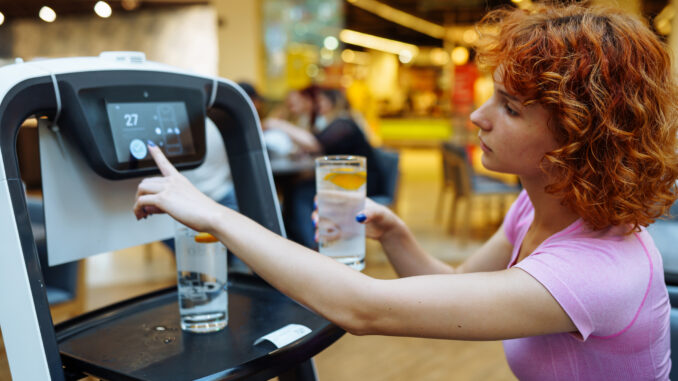
By Mariana Rosen, research analyst, Starfleet Research - 8.14.2024
The restaurant industry, known for its razor-thin margins and relentless pace, is increasingly turning to technology to optimize operations and enhance the customer experiences. The Internet of Things (IoT), with its promise of interconnected devices and data-driven insights, is rapidly transforming how restaurants operate, from the kitchen to the dining room and beyond. However, this digital transformation introduces new and evolving cybersecurity risks that demand a nuanced and proactive security strategy.
While connected thermostats and security systems, point-of-sale (POS) systems, and customer Wi-Fi hotspots offer undeniable benefits – remote monitoring, real-time data analysis, and enhanced customer engagement – they also expand the attack surface, creating new entry points for cybercriminals. Add to the mix the rapid adoption of such IoT devices as ordering kiosks, inventory management sensors, and robotic servers and chefs, and that attack surface increases by orders of magnitude. Traditional cybersecurity measures, primarily designed to protect static IT infrastructures, often prove inadequate in addressing the unique vulnerabilities of these interconnected devices.
Consider the typical restaurant IT environment: a complex network of stationary computers, mobile tablets used by waitstaff, connected kitchen appliances, and guest-facing Wi-Fi hotspots. Each device, with its own operating system, software vulnerabilities, and communication protocols, presents a potential point of compromise. Adding to the complexity, many restaurants lack dedicated IT personnel, relying instead on staff with limited cybersecurity expertise to manage these systems.
This is where a tailored approach to IoT security becomes paramount. Rather than relying on generic security solutions, restaurants need to adopt a multi-layered strategy that addresses the specific challenges posed by these interconnected devices.
Visibility: The Foundation of Effective IoT Security
The first step towards securing any network, especially one as dynamic as a restaurant’s, is establishing complete visibility. This means knowing exactly what devices are connected to the network, what software they are running, and how they are communicating with each other. Network discovery tools, capable of automatically identifying and profiling devices, are essential in this regard. These tools provide a real-time inventory of all connected assets, including those often overlooked, such as smart appliances and security cameras.
Moving Beyond Basic Threat Detection
Once visibility is established, the next step is implementing robust threat detection mechanisms. Traditional signature-based antivirus software, while still relevant, is often insufficient in detecting the sophisticated attacks targeting IoT devices. This is where machine learning and artificial intelligence come into play. By analyzing network traffic patterns and device behavior, these technologies can identify anomalies that might indicate malicious activity, even if the attack signature is unknown.
The Importance of Automated Response
Detecting a threat is only half the battle. Equally crucial is the ability to respond swiftly and effectively. In the fast-paced environment of a restaurant, every second counts. Automated response mechanisms, triggered by pre-defined rules or machine learning algorithms, can isolate compromised devices, block malicious traffic, and even shut down critical systems to prevent further damage. This proactive approach, rather than a reactive one, is essential in minimizing the impact of a cyberattack.
Empowering Existing IT Teams
While a dedicated IoT security team might seem ideal, it’s not always feasible for restaurants operating with limited resources. This is where user-friendly, centralized security platforms prove invaluable. These platforms provide a single pane of glass view of the entire network, allowing IT staff to monitor activity, manage security policies, and respond to incidents from a central location. Intuitive dashboards and automated reporting features further simplify security management, even for those without specialized cybersecurity expertise.
Measuring Success: Key Performance Indicators
To ensure the effectiveness of their IoT security strategy, restaurants should track key performance indicators (KPIs). These might include the percentage of devices with up-to-date security patches, the adoption rate of two-factor authentication for critical systems, the frequency of security incidents, and the average time to detect and contain a breach. Regularly monitoring these metrics provides valuable insights into the overall security posture and highlights areas for improvement.
The integration of IoT into the restaurant industry is not a passing trend but a fundamental shift in how these businesses operate. While the benefits are undeniable, so too are the risks. By adopting a pragmatic, multi-layered approach to security, restaurants can confidently embrace the future of connected dining, reaping the rewards of this technological revolution while safeguarding their customers, their reputation, and their bottom line.
For further reading: The 2024 IoT Security Benchmark Report, independently produced by Starfleet Research, reveals how top-performing organizations implement cutting-edge IoT security measures to protect their networks and maintain robust cybersecurity.
Palo Alto Networks is the world’s cybersecurity leader. We innovate to outpace cyberthreats, so organizations can embrace technology with confidence. We provide next-gen cybersecurity to thousands of customers globally, across all sectors. Our best-in-class cybersecurity platforms and services are backed by industry-leading threat intelligence and strengthened by state-of-the-art automation. Whether deploying our products to enable the Zero Trust Enterprise, responding to a security incident, or partnering to deliver better security outcomes through a world-class partner ecosystem, we’re committed to helping ensure each day is safer than the one before. It’s what makes us the cybersecurity partner of choice.
 Mariana Rosen heads up cross-vertical industry research for Starfleet Research, a world leader in benchmarking best practices in technology-enabled business initiatives, directing research analysts, overseeing project management and guiding the company’s custom market research deliverables. She comes to Starfleet Media with extensive experience as a senior research analyst, with subject matter expertise across multiple industry sectors. She previously served as a senior investment banking research analyst at Citigroup’s Corporate Bond Research Division, with over 100 published research reports and notes, including company initiations, industry pieces, and earnings recaps. As a labor of love, Mariana is pursuing a Ph.D. at the CUNY Graduate Center and is also a co-founder and editor-in-chief of Fine Art Globe.
Mariana Rosen heads up cross-vertical industry research for Starfleet Research, a world leader in benchmarking best practices in technology-enabled business initiatives, directing research analysts, overseeing project management and guiding the company’s custom market research deliverables. She comes to Starfleet Media with extensive experience as a senior research analyst, with subject matter expertise across multiple industry sectors. She previously served as a senior investment banking research analyst at Citigroup’s Corporate Bond Research Division, with over 100 published research reports and notes, including company initiations, industry pieces, and earnings recaps. As a labor of love, Mariana is pursuing a Ph.D. at the CUNY Graduate Center and is also a co-founder and editor-in-chief of Fine Art Globe.
Are you an industry thought leader with a point of view on hotel technology that you would like to share with our readers? If so, we invite you to review our editorial guidelines and submit your article for publishing consideration.

